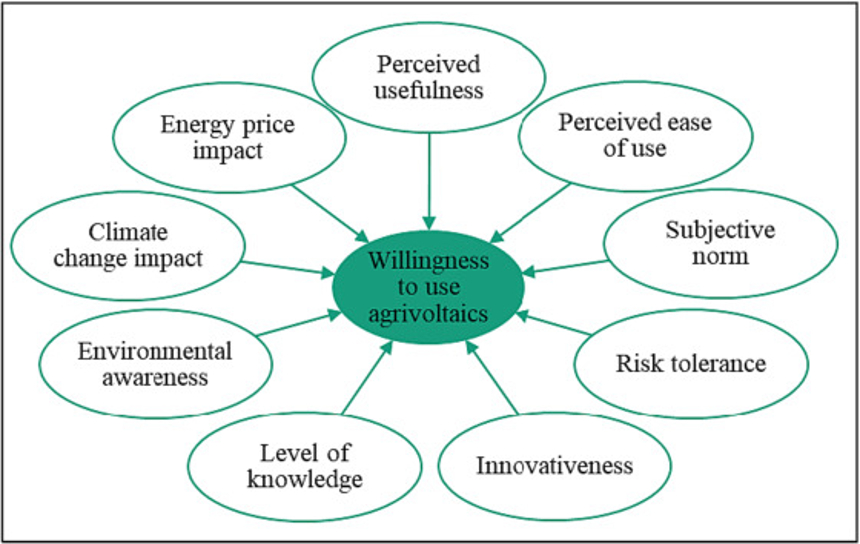Sign up for daily news updates from CleanTechnica on email. Or follow us on Google News!
Researchers in Germany associated with the world renowned Fraunhofer ISE have published a new study designed to understand what factors make agrivoltaics — the practice of combining solar panels with farming — attractive to those who do actual farming. There is much ballyhoo from fossil fuel interests around the world that seeks to paint renewable energy as an existential threat to agriculture, but it is led by people whose income depends on extracting and burning fossil fuels, not those who are struggling to make a living from farming. In fact, the livelihood of the farming community is threatened more by the byproducts of fossil fuels — excessive heat, flooding, drought, and wildfires — than it is by solar panels or wind turbines.
Scheduled to be published in the May 2024 issue of the journal Applied Energy, the researchers explain that “as a combination of agricultural production and solar energy generation, agrivoltaics helps to mitigate land use conflicts. However, this requires the willingness of farmers to adopt the technology, as without them the dissemination of agrivoltaics is not possible.
Therefore, the aim of this research was to investigate farmers’ willingness to use agrivoltaics. An online survey among German farmers was conducted in February 2023. The dataset consists of 214 farmers. In order to answer the research aim, a factor analysis and a binary logistic regression were undertaken. The results show that 72.4% of the farmers would be willing to use agrivoltaics. The ‘perceived usefulness’ of the technology has the strongest influence, followed by ‘subjective norm’ and ‘innovativeness’ of the farmer.
For farmers, the most important function of agrivoltaics is the additional source of income and the future development of the farm. Furthermore, a lack of trust in the technology is not a barrier. The bureaucratic effort and the uncertain regulatory framework are a relevant hurdle, as is the more challenging agricultural processing of the land. Future efforts should focus on addressing these challenges to enable widespread adoption and realize the potential positive impact of agrivoltaics in the agriculture and energy sector.
Understanding Attitudes About Agrivoltaics
The first aim of the study was to determine which factors influence the willingness to use agrivoltaics among German farmers. The second aim was to identify which functions of agrivoltaics are relevant to farmers and thus provide benefits, as well as which barriers stand in the way of the dissemination of the technology.
What the researchers found was that most farmers are ready, willing, and able to embrace the convergence of solar farming and traditional farming, primarily because of the expectation that agrivoltaics can lead to more stable income for them. Traditional farming is fraught with uncertainty. Yields vary from growing season to growing season, but as farming increasingly turns to high-tech equipment and the price of farming equipment skyrockets, the predictability that allows farmers to feel comfortable taking out loans to pay for it all just isn’t there.
The income from solar installations is a known quantity that does not vary from year to year. That gives farmers the comfort level they need to invest in their farms without the specter of having their equipment auctioned off if they can’t pay their mortgages and equipment loans. Those who are nattering on social media about how solar power is ruining the appearance of farming communities are not lying awake at night worrying about how to pay the bills.
9 Factors Lead To Acceptance Of Agrivoltaics

The researchers identified nine factors that influence farmers to adopt agrivoltaics for use on their own farms. Some of them are economic, such as lowering the cost of electricity to run their farms, and some are cultural. As a source of information to learn about agrivoltaics, trade newspapers are very important to the farmers followed by agricultural consultants and farmers’ associations. Other colleagues play an important role for many participants as well. By contrast, radio, television, and social media are rather unimportant for obtaining information about agrivoltaics, which suggests farmers are more likely to trust their peers than a bunch of nattering nabobs hired by fossil fuel companies to “influence” people.
The data illustrates that what respondents considered most important for their farm is generating additional income, followed by further development of the farm. Regarding energy production, the contribution to the development of renewable energies is particularly important. There are as many different types of farms as there are farmers. For those who rely on large, sophisticated equipment, there are concerns about whether the structures that support the agrivoltaics will be damaged by those machines or vice versa. That is more of a concern for growers of corn or wheat than those who grow strawberries, for instance.
There is evidence emerging that solar panels help protect some fruits like apples from hail damage and may actually promote higher yields from some crops because of the shade they provide. For farmers who raise livestock, that shade can be an important consideration as well. Agrivoltaics is an area similar to the auto industry. There is no one vehicle that meets the needs of all drivers. That’s why there are literally thousands of models customers can choose from. Likewise, agrivoltaics systems must be tailored to the specific needs of each individual farm.
The Biggest Concerns Farmers Have
The researchers found the vast majority of German farmers surveyed are open to the idea of adding agrivoltaics to their farms. What is holding them back is not fear of the technology but the regulatory and permitting barriers that have to be surmounted before they can add solar panels to their operations. In the US, political opposition to combining solar and agriculture is fierce and growing more heated by the day, as fossil fuel interests invest millions of dollars into scare campaigns designed to influence local, state, and national political decision makers. Similar efforts are taking place elsewhere around the world.
In the conclusion to their study, the researchers write that, “While agrivoltaics is still emerging, the growing discourse and supportive regulations indicate increasing interest in the technology. The current research contributes to this discourse by providing empirical evidence of the factors influencing farmers’ acceptance of agrivoltaics. It underscores the central role of ‘perceived usefulness’, aligning with existing literature.
“Notably, the diversification of agricultural operations and the generation and sale of renewable electricity are seen as primary. Furthermore, the study highlights the influence of the ‘subjective norm’ on agrivoltaic acceptance, emphasizing farmers’ awareness that the implementation of agrivoltaics extends beyond their operations, affecting their social environment. However, the study also notes that the social acceptance of agrivoltaics is not firmly established, possibly due to concerns about visual changes in the agricultural landscape. The analysis also confirms the influence of ‘innovativeness’ on the willingness to use agrivoltaics. The role of the ‘sense of responsibility towards the environment’ needs additional research.
“While the research indicates relatively minor doubts about the technology and its economic benefits, the bureaucratic hurdles associated with construction represent a significant barrier. Importantly, the results reveal a nuanced perspective on the protective functions of agrivoltaics, which farmers only partly recognize. This may arise from the need for additional scientific and practical evidence showcasing the technology’s potential to provide protection and synergies for agricultural practices.
“Further research and practical initiatives are needed to remove bureaucratic barriers, increase social acceptance, and provide concrete evidence of the protective functions of agrivoltaics and potential synergies with agricultural practices. These efforts are essential to promote the adoption of agrivoltaics and its positive impact on both the agricultural and energy sectors.”
The Takeaway
Farming is a hard way to make a living. There are so many factors that are outside the control of farmers that impact how profitable each crop will be. In the US, farmers can’t get their goods to market by sending them down the Mississippi River as cheaply as they could a few years ago because low water levels associated with droughts caused by climate change mean barges can’t carry as much cargo as they did before.
Everything is connected. A butterfly flapping its wings over Nigeria may or may not lead to a hurricane in the Gulf of Mexico, but grain shipments that cross oceans leave a trail of carbon and sulfur emissions in their wake that will affect rainfall in many farming communities. The fertilizers and pesticides modern farmers rely on are mostly derived from oil and gas, both of which contribute significantly to changes in the environment that make farming more tenuous and less profitable.
Thanks to research like this, we now know that what farmers want most is not a truckload of malarkey cooked up by some think tank on the Potomac, but rather hard information that will help them prosper. Beliefs and opinions don’t put food on the table or money in the pockets of farm families; science and information do. In the final analysis, harvesting sunlight is a form of farming. Figuring out how to do that more reliably and efficiently is vital to the interests of us all.
Featured photo (cropped) courtesy of Connexus.
Have a tip for CleanTechnica? Want to advertise? Want to suggest a guest for our CleanTech Talk podcast? Contact us here.
Latest CleanTechnica TV Video
CleanTechnica uses affiliate links. See our policy here.




